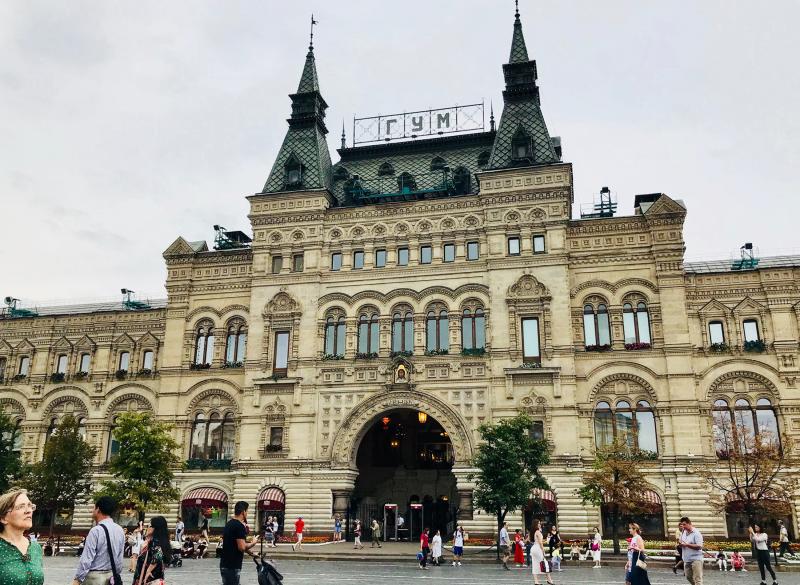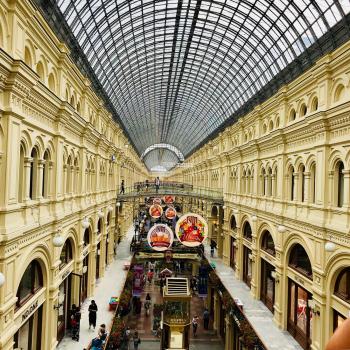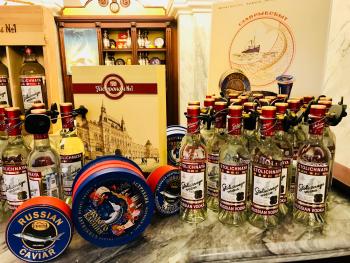A foodie’s dream day at Moscow’s GUM
This article appears on page 18 of the August 2019 issue.
If you would be interested in visiting a department store that is unlike any other store you know, then put Moscow’s GUM on your travel bucket list.
You cannot compare GUM with Le Bon Marché in Paris, Harrods in London or Isetan in Tokyo. No, GUM (www.gumrussia.com) is the giant, architecturally dramatic shopping-and-dining mall that frames most of the east side of Moscow’s Red Square.
GUM is unique in that it is basically a complex of three parallel 3-story malls, festooned with giant skylights, and more akin to a historic church or museum than any other shopping venue. You might think of GUM as a kind of upscale Mall of America on historic Russian steroids.
A bit of history
Dating back to the late 19th century, GUM’s steel-frame architecture is similar in style to the great railway stations of London and Paris. The trapezoidal framework supports a cantilevered 700-ton glass roof containing more than 20,000 panes of glass framed in Tarusa marble, limestone and Finnish granite, and over 20,000 bulbs brilliantly illuminate the exterior sections of the complex at night. One of the oldest shopping complexes in Europe, GUM is a tourist mecca and one of Moscow’s most popular attractions.
Russian Premier Joseph Stalin closed GUM in 1930 and government departments and ministries occupied the premises. During the post-World War II period of the Soviet Union, the third floor contained what was known as “Section 100,” a secret custom-clothing store open only to top Communist party officials.
In 1947, Stalin announced his plans to demolish the 3-building complex, but he never got around to issuing the destruction order. His successor, Georgi Malenkov, had GUM restored and reopened in 1953 as a sign of easing East-West tensions. Its large modern theater, used for plays, operas, ballets, concerts and movies, and its famous winter ice-skating rink fronting Red Square were redesigned, rebuilt and opened just over a decade ago.
Gourmet shopping
Led by Olga Sukurova, a former student of mine, a fellow foodie and a Moscow resident, my wife, Maria, and I spent most of a day last August touring GUM with a focus on local foods. You can wander GUM’s 165-plus international-brand shops and rarely hear a word of Russian, except around the 20 food outlets, where most of the clientele are local Russians who have made GUM Moscow’s go-to food epicenter.
We started with a late breakfast at Coffeemania, which features a variety of shop-roasted coffees and a plethora of Russian pastries. We ordered lattes and shared a cheese pierogi, a generous slice of chocolate plum cake and a trubochka, a thick-crusted pastry stuffed with cream. Per person, the cost was 450 rubles ($7).
This striking coffee shop overlooks GUM’s dramatic central fountain and features oak-framed glass tables and armchairs covered with luxurious velvet fabrics.
We next went on a mini gourmet-food shopping spree at GUM’s foodie highlight, Gastronome No. 1, which occupies almost one-third of the store’s 250-yard-long first floor. An architectural treasure of its own, Gastronome No. 1 features intricately carved arches supported by marble columns, giant crystal chandeliers and gallery-worthy signage. Even the shopping baskets we grabbed reflected style and comfort, sporting leather and brocade handles.
This giant gourmet supermarket has some 25 separate sections, featuring everything from a collection of over 20 olive oils and 100 different spices to live lobsters, oysters and crabs. A huge salad bar and adjacent sausage and herring counters are local take-out favorites.
More than 100 cheese choices and traditional and modern desserts plus candy sections overwhelm the eye, all interspersed with kiosks offering gourmet ice cream, fresh sushi, beluga caviar and a variety of food-gift options.
The alcohol section features a large offering of beers from around the world, and GUM’s wine and vodka collections are among the largest in Moscow.
We like to bring home local food samples as gifts and for our own consumption, and after a long, careful review of the hundreds of possibilities, we filled our baskets with a variety of Moroccan spices and Russia’s well-known, locally produced chocolate bars and coffee.
Dining options
Exploring Gastronome No. 1 for over an hour, we were ready for lunch. We chose Stolovaya No. 57, a self-service canteen that featured a wide variety of traditional dishes, from knishes to khinkali (miniature meat dumplings) and borsht to blini.
We tried the local solyanka soup, stuffed cabbage, chicken Kiev with rice and cherry strudel. We have had better chicken Kiev, but the other dishes were wonderful. The per-person cost with a soft drink was 1,000 rubles.
To work off our heavy lunch, we dedicated our afternoon to intensive window shopping among GUM’s international-brand clothing, accessories, jewelry, electronics, housewares, toy and gift shops, interrupted only by a mid-afternoon stop for delectable ice cream at a Mopokenoe ice cream kiosk.
Our favorite brand shops included Hermès, which carried all lines of the famous Paris store, from clothing and leather goods to dishes and riding gear; FREYWILLE of Vienna, featuring exotic jewelry; the Bulgari collection of jewelry and watches that emphasize the link from ancient Rome to modern Milan; the award-winning, premium home appliances from Bork, including toasters, blenders and coffeemakers, and the Crystal and Porcelain Salon, which featured sets as well as unique and limited-edition pieces of porcelain, crystal and earthenware.
For dinner, we chose the elegant Bosco Cafe, fronting Red Square. We dined beneath the café’s huge Murano-glass chandelier designed especially for Bosco at the Seguso factory in Venice. We ate from porcelain dinnerware designed and manufactured by Richard Ginori, outside Florence, to match the café’s ceiling frescoes.
All of the dishes in our dinner of borscht, beef Stroganoff, biskvit (a sweet wine cake) and chocolate tart were first-rate (1,700 rubles per person with a glass of wine).
For a bio break, we could not resist the store’s “historic” bathroom, where for 70 rubles, you can experience marble bathroom fixtures, teak walls and gold-trimmed mirrors. A special option for ladies (475 rubles) provides a shower, robe, bath towels and slippers.
You will find GUM much more than a shopping emporium where you can buy most anything. It is a monument to Russian engineering and architecture, with comfortable lounge areas, restaurants and cafés. It is an art gallery and the home of cultural events. But most of all, it is a symbol of Russia’s history, Moscow today and a vision of its future.




